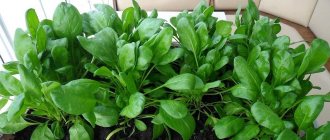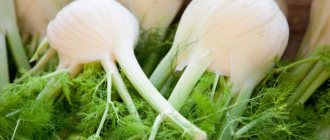A plastic window sill is an indispensable attribute of PVC windows. One of the advantages of plastic is its resistance to contamination, but if something stains a perfectly white surface, it cannot be washed off so easily. Let's figure out how to clean a plastic window sill!
In winter, there is such a shortage of fresh herbs and vegetables from the garden. What can you grow on your windowsill to enjoy natural products? The list of crops suitable for apartment conditions is quite wide - from parsley and lettuce to tomatoes and cucumbers.
You can grow greens on a windowsill in winter or summer in the same way as in the garden. But keep in mind that some plants are quite demanding. In this article we will look at easy-to-care crops.
If you are a beginner gardener, and therefore do not know what you can grow on the windowsill, then it is better to start with green onions, watercress, and parsley. And herbs - basil and rosemary - will not only come in handy in the kitchen, but will also spread their aroma throughout the apartment. More experienced amateurs can immediately start by growing cucumbers, tomatoes, and peppers.
Children will also enjoy the winter garden. Even a toddler can grow green onions on the windowsill. Caring for plants will not only captivate the child and give him a new useful experience, but also provide him with vitamins.
Preparation
After you have decided what to grow on the windowsill, you need to prepare pots, soil, and seeds. The set is the same for most cultures. Experienced summer residents who know how to grow seedlings on a windowsill already have almost everything they need.
To set up a vegetable garden on a windowsill, you will need deep boxes or wide flower pots for planting plants. They can be equipped with plastic covers to create a greenhouse effect. For these purposes, you can also use ordinary plastic bags.
The pots need to be filled with soil from a flower shop or a self-prepared substrate. It is better to avoid using soil from the garden or vegetable garden, as insect larvae and weed seeds may remain in it. If the soil from the street is not prepared and calcined, then there is a high probability that you can grow one weed on the windowsill.
You also need to prepare a container for settling water - tender young plants should not be watered directly from the tap. You will also need a spray bottle or a small watering can.
Foil placed behind plants to reflect sunlight will also be useful. If foil is not used, then boxes and pots with plants must be turned 180 degrees daily, otherwise they will tilt towards the window and grow crookedly.
If the plants are grown in spring and summer (planting in February-March), then they will have enough sunlight from the street. But a winter garden planted in the fall will require additional lighting. Fluorescent lamps are suitable for this.
You should understand that you can only grow undemanding herbs on a windowsill in winter without lighting, but you won’t be able to get a good harvest of tomatoes without using phytolamps. In winter, on sunny days, additional lighting will be needed in the evening, but in cloudy weather, the lamp will have to be turned on for the whole day.
Tomatoes and cucumbers
In addition to carrots and peppers, you can grow other vegetables on the windowsill, in particular tomatoes and cucumbers. The former require the same soil as peppers, but it is better to give preference to store-bought mixtures. The pot should be cylindrical, as this will allow the root system to fully develop.
To begin with, the seed must be germinated in small pots, burying the seeds 1.5 centimeters into the soil. Then the crops are covered with polyethylene and left in a warm place until the first green shoots appear. As soon as the tomatoes sprout, they need to be dumped into a larger container.
In order for tomatoes to develop quickly and correctly, they need to be provided with suitable lighting conditions. You should hang a fluorescent lamp over the mini-garden or constantly turn the container towards the window.
Watering the beds should be moderate, because cherry tomatoes are afraid of stagnant moisture. As soon as the plant gets stronger, the substrate can be loosened and fertilized with mineral compounds. If necessary, the crop trunk is tied to a support. This could be a small skewer or pencil. In addition, it is important for the vegetable grower to constantly monitor the condition of the plant, preventing the appearance of pests and diseases.
As for cucumbers, larger pots need to be prepared for them. Their volume must be at least six liters. The substrate chosen is loose with a high content of peat or compost.
When grown at home, self-pollinating varieties bear fruit well. The first step is to prepare the seed, following these instructions:
- The seeds are poured into a saline solution. If any of them float to the surface, then you need to throw them away.
- Prepared seeds are soaked in a manganese solution for 20 minutes, and then they are washed on damp gauze and placed under film.
- As the first sprouts peck, the cucumbers are planted in large pots.
Watering cucumbers should be daily, but care should be taken when performing this procedure. A spray bottle is used to spray the leaves, and potassium nitrate is used for feeding. As soon as the crop's lashes are finally formed and grow, they need to be tied to supports.
Green onions
Children are shown how to grow onions on a windowsill in kindergarten. This is the easiest crop to grow at home, it does not require special care, grows quickly and is very useful.
To force feathers, you can use both large onion sets (selections) and ordinary onion turnips. Feathers from a small bulb are more delicate, but the small head wears out quickly. A larger bulb produces abundant greens for a longer period of time.
Not only self-grown onions are suitable, you can also use those purchased at a supermarket or a store for summer residents. The easiest way to plant onions for forcing is in water. To do this, you need to take a small glass and fill it with plain water or a nutrient solution. The bulb must be installed so that only its tip touches the surface of the liquid. You need to change the water every day.
When planted in water, the bulb may begin to rot and emit an unpleasant odor. This can be avoided, since you can grow onions on a windowsill by planting them in the ground. The substrate should be poured into a shallow plastic box. If there are no drainage holes at the bottom of the container, then to prevent rotting of the roots, it is reasonable to pour a small drainage layer of expanded clay, pebbles, broken bricks, etc.
There is no need to bury the heads; plant them tightly; the bulbs are not afraid of close proximity. Plantings must be watered frequently, preventing the soil from drying out. Do not use all the seed material at once, it is better to break it into several portions and plant it 2-3 weeks apart, then there will be enough fresh onions for the whole winter.
Green onions can be grown not only in boxes. Onions for forcing can be planted vertically. To do this, you can purchase a special flowerpot at a store for summer residents or make holes yourself in a plastic bottle filled with soil.
Growing without soil
A significant number of different options for planting greenery without using standard soil have been worked out. Cotton wool and sawdust are used. With these methods, the main thing is light, moisture, minerals:
- Hydrogel. The composition is first filled with water and the swelling time is expected. Next, put it in a colander and drain. Seeds are poured on top, without pre-soaking. Covered with film, germination occurs after seven days. The sprouts are collected and planted in the ground.
- Cotton wool. The process is the same as in the previous version.
- Egg trays. They have become particularly relevant when growing onions. Holes are made in the plastic to allow water to drain. The trays are installed on top of each other, and a special gasket is installed to provide clearance. To fully understand the structure of the organization of the method, you need to watch the video.
- Paper. It should be abundantly moistened with water. Seeds are subsequently laid out on its surface. The roll is rolled up (loosely). It is placed in a glass of water. After the first shoots appear, the procedure of transplanting into the ground is carried out.
Please note that sawdust is considered the most relevant method. They have a greenhouse effect, which ensures the possibility of intensive germination of any seeds.
Watercress
What can a beginner grow on a windowsill? Another simplest crop to grow on a windowsill is watercress. It is known for its beneficial properties, and its unpretentiousness makes it one of the most common salads to grow at home. Watercress is ready for consumption within 2-3 weeks after planting. Seeds can be purchased at a gardening store.
To grow lettuce, you don’t need a deep container; a regular tray will do. As a substrate, you can use a thin (about 3 cm) layer of clay or peat soil, fabric folded several times, cotton wool or paper towels.
Watercress should be planted densely so that the young plants support each other. Press the seeds a little into the moist substrate. The plant does not require additional lighting; just place it on the windowsill.
How to grow lettuce on a windowsill? The main thing is not to let the soil dry out, although you shouldn’t overwater the salad either. The plant does not like heat. The optimal temperature is no higher than 18 degrees Celsius. To avoid overheating in winter, just move the container with the salad closer to the window.
In order for green watercress to be constantly present on the table, you need to plant it according to a scheme that is convenient for you. You can sow a new container every week or two or add a small amount of seeds every 3-4 days.
Organizing a vegetable garden on a windowsill
To create a small home garden on a window in winter, you will need careful preparation:
- Plastic containers (cut bottles, glasses are suitable) or flower pots.
- Polyethylene to organize a mini-greenhouse.
- High-quality soil and fertilizers intended for vegetables and herbs.
- UV lamps to create daylight.
- Thermometer to control the temperature of your home garden.
- A small watering can for watering the garden.
Soil can be purchased at any specialized gardening store. Then they need to fill the prepared containers and water so that the soil gets wet. Then the seeds or seedlings are planted. In the case of seed planting, the containers must be placed in a warm place and covered with film to create a greenhouse effect until the crops begin to germinate.
As soon as the sprouts appear, the polyethylene must be removed to ensure air circulation and transferred to the windowsill, where the plants will have access to daylight.
The key to quality plants and a successful home harvest is timely watering, fertilization and access to daylight. Since there is little natural light in winter, you will need a daylight lamp.
If you don’t want to plant seeds, you can purchase already sprouted crops in the store and simply transplant them into containers at home.
Leaf salad
Growing leaf lettuce is already somewhat more difficult. To know how to grow lettuce on a windowsill, you need to take into account the variety of the plant being grown. The varieties Lollo Rossa, Lollo Bionda, Odessky, Vitaminny, New Year, and Red Credo perform best in apartment conditions.
In autumn and winter, leaf lettuce will need additional lighting. If the room is hot and dry, the plant does not receive enough moisture, then the leaves will become bitter, become coarse, and flower stalks will quickly form. Leaf lettuce loves moisture and coolness and feels good on a glassed-in balcony until late autumn.
Leaf lettuce is planted in the ground quite densely, at a distance of 1-2 cm. Before the first shoots, the container is covered to create a greenhouse effect. Over time, thinning to a distance of 4-5 cm will be necessary. The plant needs watering and good lighting.
After the bushes begin to produce arrows, they become unsuitable for consumption. They can be removed and new seeds planted in their place.
What can you grow on a windowsill?
The main question is, what will we plant? In fact, you can grow almost anything your heart desires on a windowsill. It all depends on your experience, desire, as well as the amount of effort and time you are willing to spend to achieve your goal. Below you will become familiar with the finer nuances of growing garden crops at home.
Homemade greens
Growing greens on a windowsill is easy; green onions, parsley, basil and lettuce are commonly used.
Green onions
For planting, take onion sets or regular onions.
Sometimes onions are planted in containers with water, but if the gardener is committed to quality, then it is better to choose soil. This way the onions will definitely not rot. It is better to use plastic containers.
Drop off procedure:
- Expanded clay is poured onto the bottom, soil with hydrogel is poured on top to the middle of the container.
- The bulbs are placed close to each other in the soil, without going deep into the soil.
- Water generously.
If the harvest is needed constantly, onions are planted every 10-14 days. No special procedures are required.
Leaf salad
Leaf lettuce is more demanding to grow than onions, but it can be planted. The main thing is to remember the main aspects:
- Additional lighting will be required, but part of the problem is solved by choosing the right variety, for example, Lollo Rossa. For a vegetable garden on a windowsill, the New Year or Vitamin variety is suitable.
- Lettuce does not like drought and heat, which is why the leaves become bitter.
- The seedlings should be thinned out preferably 2 times: a week after their appearance and when 2-3 leaves grow. When thinned, plants produce more yield.
When the lettuce shoots out its arrows, its harvest is unfit for consumption. The arrows are removed and new seeds are planted in their place.
Parsley
Parsley is harvested in 2 ways:
- Sowing seeds into the soil. The seeds grow slowly (1.5 months), but the bush lasts a long time. Before planting, the seeds are soaked in a solution of potassium permanganate, then planted in convenient containers.
- Forcing from roots. If there is no material, then root vegetables are purchased at the store. Healthy roots of medium size with a preserved apical bud will be required. The roots are planted in abundantly moistened soil, covering the top with soil.
Parsley grows well on windowsills, is not sensitive to temperature conditions, and loves abundant watering.
Dill
Not the best choice for a window sill garden. The culture is demanding, and the seeds do not germinate well.
Planting procedure:
- The seeds are soaked for 48 hours, the water is changed every 12 hours.
- Plant the seeds in a container with soil, making holes 1 cm deep and sprinkling with water.
- Sprinkle with earth and create a greenhouse effect on top.
- The container is sent to the windowsill.
It is necessary to maintain a temperature of at least 18 °C. After the emergence of seedlings, the greenhouse is removed.
Basil
Any variety of basil can be selected; the crop is propagated by seeds or root crops. It grows whimsically: the temperature is about 23 degrees, with plenty of watering.
It’s easier to grow basil by roots, placing it in water, and after 10 days replanting it in a container with soil. You can cut the first harvest in 2 weeks. But after flowering, basil is unsuitable for food.
Parsley
Many housewives are wondering how to grow parsley on a windowsill. After all, you often only need a few leaves of this plant, and you don’t want to buy a whole package in the store. In spring and summer, parsley can be grown from seeds.
The plant is light-loving, so in winter it will need additional lighting. The seeds germinate rather slowly, but the bush will last a long time. Parsley is not picky about temperature; it grows well on a windowsill or balcony. The plant is moisture-loving and is watered abundantly. In winter, parsley needs to be watered less often.
It will be possible to cut the first greenery only after a month and a half, but it will be possible to do this for a whole year. Before planting, it is better to soak the seeds in a solution of potassium permanganate. You can plant parsley in small containers, in peat cups or directly in flowerpots.
How to grow parsley on a windowsill in autumn and winter, because growing from seeds at this time is too long and labor-intensive? There is another way - forcing it from the rhizome. This method is somewhat simpler and better suited for the autumn-winter period. Planting material can be prepared independently in a personal plot or purchased at a regular grocery store.
The rhizome must be healthy, without signs of wilting, and the apical bud must be intact. The root crop should be placed in a pot and sprinkled with damp soil. Roots that are too long can be planted at an angle.
The first green shoots will appear within a few days after planting, and the leaves can be cut off in a couple of weeks. Greens will appear on the rhizome within six months.
Basil
What can you grow on a windowsill besides regular onions, parsley, and lettuce? Something more exotic like basil or rosemary.
The type of basil does not matter; green or purple will do. Basil can be propagated either from seeds or from cuttings. The plant is thermophilic - the optimal temperature is 20-25 degrees, and moisture-loving - good drainage and abundant watering are required.
Cuttings are a quick way to grow basil. You can simply buy a few branches in the store, put them in water and after one or two weeks move the seedling with roots into a pot. The young shoots will be ready for cutting in a couple of weeks. It is better to cut off the side shoots.
Basil planted from cuttings grows quickly, but also blooms quickly. As you know, after the start of flowering the plant is unsuitable for food. To have fresh basil on your table all the time, you need to replant the plantings every 3-4 months.
Planting basil from seeds will require more effort. But such a bush will not bloom for about a year. The seeds need to be soaked, covered, and the sprouts transplanted into pots. It is better to grow basil using seeds in the spring, since additional lighting will be needed in winter.
Necessary growing conditions
In the garden, for example, peppers or cherry tomatoes can be planted only seasonally, since changes in weather conditions often cause crop failure. In this regard, growing on a windowsill has an undeniable advantage - the ability to maintain ideal climatic conditions to obtain optimal results.
Basic conditions:
- Standard lighting lamps of any type are installed above the pots (the distance is no more than 50 cm). When the day is cloudy, they are turned on, providing an increased amount of light to stimulate growth. The duration of light action should be at least 10 hours to obtain the best results.
- It is necessary to monitor the humidity, it must be constant and high enough. Spraying is carried out constantly. The heating device is hung with wet towels (provides steam generation and becomes the basis for increasing the level of humidity in the room). It is recommended to purchase a humidifier. Watering is not frequent. But the process of treating plants with water should be at least two to three times a week.
- Fertilizer is produced systematically using synthetic and natural products. Uniform growth is ensured by turning the flowerpots (180 degrees). It is not always convenient to use organic matter at home; the best solution would be to feed it in a soluble format.
Rosemary
Rosemary in a clay pot on the windowsill will not only decorate the kitchen, but will also come in handy when cooking. This plant can be grown in the summer in the country, and in winter it will feel great at home.
You will need a wide pot with a thick drainage layer. Rosemary is demanding of light and air. It prefers the south side, and in summer the pot with the plant must be planted in open ground, taken out to the balcony or placed outside the window, otherwise the leaves will not accumulate a sufficient amount of essential oils.
Both seeds and cuttings are suitable for planting rosemary. The seeds of the plant have poor germination. They need to be soaked for 2 days, then placed on the ground without sprinkling on top, covered with film and sprayed every day with a spray bottle. If seedlings do not appear after 4 weeks, new seeds are planted. When the seedlings produce three or more leaves, they are planted in spacious pots.
It is easier to grow rosemary using cuttings. For this you need a woody shoot of the plant. It is placed in a container with water or wet sand, and after rooting it is transplanted into a pot.
Rosemary loves frequent but moderate watering. It is better to dry out the soil than to flood it. If there is a lack of moisture, the lower leaves of the plant will begin to turn yellow, and if there is an excess, the roots will rot, which will lead to the death of the plant.
If you provide the plant with a low temperature (up to 5 degrees) in winter, then rosemary will bloom in the spring. An adult plant needs to be constantly trimmed to form a bush.
Advantages of a mini-garden
There are many advantages to growing greenery in a city apartment. First of all, the following arguments are taken into account:
- Family members will always be able to enjoy fresh, environmentally friendly and healthy vegetables and herbs at any time of the year. And during a period of lack of access to vitamins, this opportunity looks very attractive.
- An important argument is the complete savings on the purchase of vegetables and fruits, which are sold at high prices in the winter. A home mini-vegetable garden deprives household members of the need to adapt to the season and consume specific products only at a specific period of time.
- Setting up an indoor vegetable garden allows you to expand your knowledge of biology, as well as gain a lot of useful experience and find a good hobby.
- The opportunity to receive positive energy from the process of growing a crop from a seed. In addition, the youngest family members will be able to watch the growth of tomatoes, cucumbers and other vegetables. Having fresh vegetables and fruits available in winter is a great way to surprise guests by showing them green beds on the windowsill.
Healthy!
The most important advantage of a mini-garden on a windowsill is its environmental friendliness. Home-grown greens are much healthier, since they are not fertilized with synthetic fertilizers and harmful pesticides.
cucumbers
Growing cucumbers on a windowsill in winter is a rather tempting prospect. This can be done not only by an experienced gardener, but also by a beginner. Cucumbers grow quite quickly; you can get the first harvest in just a month and a half.
Not every variety of cucumber is suitable for growing on a windowsill. Firstly, it must be self-pollinating. During flowering, the bush must be shaken daily for pollination to occur. Secondly, it will be much more convenient if the plant is a bush plant. Thirdly, an early variety is better suited for home growing.
Finally, a shade-loving plant is ideal. You can grow cucumbers on the windowsill in winter of the varieties Connie, Masha, Legend, Debut, Polet, Babylon. Knowing the necessary parameters, you can choose another variety.
Growing cucumbers at home has its own subtleties. After all, providing all the necessary conditions can be difficult. Cucumbers are light-loving, so windows on the south and east sides are suitable for growing them. If there is still not enough light, then additional illumination will be required using fluorescent lamps.
The room temperature should not be below 20 degrees, so you should not move flowerpots too close to a cold window. Cucumbers love moisture very much, so you need to make sure that the soil does not dry out. The flowerpot with the plant can be placed in a bowl of water. The leaves need to be sprayed with a spray bottle twice a day.
Spinach
Spinach is one of the most beneficial foods for the human body.
Spinach is one of the most beneficial foods for the human body. It contains the entire complex of vitamins, as well as amino acids, micro- and macroelements.
Ideal for sowing at any time of the year. 40 days after sowing the seeds, you will decorate the holiday table with fresh spinach leaves. You can sow spinach in a container.
Note: Choose a container for sowing with a depth of at least 15 cm.
For cultivation we use ready-made soil (except peat). Before planting, soak the seeds for a day and sow them at a distance of 5 cm from each other, to a depth of 1.5 cm. Water as usual, making sure that the soil does not dry out! We maintain the temperature in the room at 18°C. In cloudy weather, it is advisable to turn on additional lighting using a phytolamp. Gardeners recommend such varieties of spinach as: Gigantic (ripening period 30 days), fat-leaved.
Growing greens can “revive” the interior
Tomatoes
Many people think that growing tomatoes on a windowsill is a very difficult task and inaccessible to a beginner. But this is not true at all! Moreover, there are special varieties for indoor cultivation.
When visiting a gardening store, note that some seed packages say “Recommended for pot growing”, “Window harvest”, “Home garden”. And the names of the varieties themselves are telling - Room Surprise, Balcony Miracle, Japanese Room. There are also hanging varieties that will look great in flowerpots - Peruvian Homemade, Cherry, Talisman.
Even if you don’t find special indoor varieties, regular ones will do. Please note that these tomatoes must be determinate (short, or better yet dwarf), self-pollinating (for pollination, the bushes are shaken during flowering) and small-fruited. For example, Alaska, Bonsai, Bonsai micro, Pearl (red and yellow), Canada News, Minibel, Pinocchio, etc.
Tomatoes can be planted immediately in large pots or picked, choosing the strongest sprouts. During the period of flowering and fruit set, tomatoes need to be watered generously and the leaves should be sprayed.
The room where tomatoes grow needs to be regularly ventilated - plants do not like stagnant air. In winter they need additional lighting. The plant must be fed periodically. The first fruits can be obtained in 3-4 months.
Tomato is a perennial plant. At home, with good care, it will bear fruit for several years. After a period of active fruiting, the bush needs to be transplanted into a larger pot and updated by pruning the branches. In addition, tomato can be propagated by cuttings. A plant grown from a cutting will begin to bloom within a few weeks.
Is it possible to grow exotic plants at home in winter?
There are two opposing opinions about growing exotic plants at home: some believe that it is practically impossible, others do not see anything difficult in it and even show lemons and grapefruits grown with their own hands.
The fact is that citrus trees have traditionally grown in Russian homes, despite the unsuitable climate, and there are both successful and negative experiences. And all because someone is content with a beautiful tree with fleshy leaves that never fall off and saturate the room with the purest air, while others certainly want to see ripe fruits and consider their absence to be an unsatisfactory result.
In fact, from an unprocessed lemon or orange seed purchased in a regular store, there is a 90% chance that a beautiful citrus tree will grow . But in order to refine your plant into a so-called cultivated tree and subsequently get a harvest, you need to take into account many nuances and even take advice, or even the help of a specialist.
However, nothing is impossible, and if you take into account how long it takes for an exotic tree to develop, then its seed can be planted at any time, and what to do then - be content with little or do everything so that it begins to bear fruit - will be decided over time as time goes by. its development.
Sweet pepper
How to grow peppers on a windowsill? Doing this is no more difficult than growing tomatoes. True, you will have to wait longer for the harvest - 5-6 months. But pepper is a perennial plant; with good care, annual replanting and pruning, it will bear fruit for several years.
The plant can be propagated not only by seeds, but also by cuttings. Caring for peppers is also similar to caring for tomatoes, but with one significant difference - while the tomato does not tolerate stagnant air, the pepper is afraid of drafts, so it is better not to place them on the same window.
Self-pollinating early-ripening varieties are best suited for growing in an apartment - Californian Miracle, Oda, Jupiter, Patio-Ivo.
Pepper needs good light, warmth, and loose soil (it is necessary to loosen the soil regularly). This plant is not capricious, and will delight you with its fruits for a long time. You can also grow hot peppers at home, but these plants should not be in the same room, otherwise cross-pollination will occur.
Sometimes you want to go out onto the balcony, like Jamie Oliver, pick up your own grown vegetables and herbs and make something stunning out of them. And the balcony, by the way, looks much nicer if it contains not old pieces of iron that should be sent to a landfill, but aromatic herbs and vegetables.
Bright Side has selected several interesting plants that take root well on a windowsill or balcony.
Pepper
You can grow hot pizza peppers Diablo on your windowsill. It will require a warm, bright place and varieties suitable for home cultivation: “Carmen”, “Flint”, “Ogonyok”, “Ryabinushka”, “Bride”, “Indian Summer”, etc.
The bushes are very cute and do not require large pots. One plant can bear up to 50 fruits. The optimal temperature is 25-27 degrees Celsius.
Carrot
To grow carrots at home, it is better to take mini-varieties such as Parmex, Sofi, and Vnuchka. They grow in 80-90 days and do not require much space - they are quite happy with a pot or container. You can also take the funny round variety “Round Baby”.
The soil for carrots should be light and well-drained. The vegetable can be grown in cut plastic bottles. The optimal temperature is within 13-24 degrees Celsius.
Mint
Mint is a non-capricious and undemanding plant. It can grow on your windowsill or balcony even in winter, if you provide additional lighting. It can be grown from cuttings and seeds. If you have the opportunity to dig up cuttings at your own or friends’ dacha, it is better to use this method. Mint grown from seeds is not as widely accepted, and you will have to wait longer for the harvest.
It is important to remember that the plant loves well-moistened soil. And, when you choose a place for it, keep in mind that the lighting should be good, but it is better to avoid direct sunlight. The optimal temperature for mint is 20-25 degrees plus.
Green onions
To grow green onions at home, no special dexterity is required. But it’s still worth taking into account some nuances: the bulb that you will plant should be round, dense to the touch and without signs of rot, the root cup should be well formed.
Immediately after planting, you should put the onion in a cool, dark place so that the root system can better form, and only then will the onion need a lot of light. The optimal temperature is 18-20 degrees; you should not overheat, because then the growth of greenery will stop.
Basil
Any variety of basil grows well in flower pots and boxes. It is better to give it a sunny place, water it well, keep it warm and provide good drainage. For planting, you can use both cuttings and seeds. In this case, the cuttings will quickly produce the first harvest, but will not last long, as they will bloom quickly. You will have to wait longer for the harvest from the seeds, but such a bush will also last longer.
The optimal temperature for basil is 20-25 degrees Celsius. In winter, backlighting is required for approximately 3-4 hours to increase daylight hours.
cucumbers
To grow cucumbers on a windowsill or balcony, you should take a closer look at the hybrid varieties that are marked with the F1 icon. If all conditions are created for the plant, it can produce 3-4 dozen fruits. Here you will have to tinker a little with the seedlings, but after transplanting into boxes you will only need to water and trim the tendrils.
Plant plants in containers with a volume of at least 5 liters. It is important to remember that cucumbers are big water feeders and the soil should always be moist. The optimal temperature is 21-24 degrees Celsius.
Tomatoes
Dwarf varieties are usually chosen as home tomatoes: “Minibel”, “Florida Petit”, “Balcony Miracle”, etc. You will have to allocate the most illuminated place in the apartment to this miracle. You will need to start with seedlings, then plant them in containers, tie them up, feed them and protect them from the cold. This is one of the most troublesome balcony crops, but the harvest comes with pride in the work done and gardening talent.
It is important to remember that tomatoes, like all plants, love water, but they are easy to water. Therefore, watering should be done carefully. The optimal temperature is 23-25 degrees Celsius.
Sorrel
In addition to its wonderful taste, sorrel is distinguished by the fact that it tolerates shaded areas. It can be grown from the rhizomes of 2-4 year old plants with buds or from the seeds of such varieties as “Maikopsky”, “Altaisky”, “Odessky broadleaf”.
It can grow at 5 and 20 degrees Celsius and can even withstand slight frosts. So you can keep it on the balcony until the last minute, and if the balcony holds the heat well, then you don’t have to put it away for the winter. Leaves are cut at a height of 8-10 cm; this must be done carefully so as not to damage the growth buds.
Ginger
Ginger is not only a delicious seasoning, but also a beautiful plant. If planted at home, the sprouts can grow up to a meter in height. Plant pieces of ginger root, consisting of at least a couple of sections with live buds. If the root has dried out, you can keep it in warm water for several hours so that the buds wake up.
The root should not be planted very deeply, and until the first shoots appear, it should be watered very sparingly. Ginger should be kept in the light, but away from direct sunlight. The optimal temperature is 20-25 degrees Celsius.
A pineapple
To grow a pineapple at home, you need to be patient and find a suitable fruit - purchased in the warm season and with an intact tail. The tail is cut off with a knife, preferably without pulp, dried for 3-4 days in the light, and then germinated in clean river sand. When the roots appear, after about a month, it can be transplanted into a pot with soil.
Pineapple loves light, warmth and spraying. The fruit will appear about 2 years after planting. The optimal temperature is 23-30 degrees Celsius.
Strawberry
Strawberries can be grown at home all year round; in winter you will need to provide lighting. To do this, you should choose remontant strawberry varieties that bear fruit not just once a season, but constantly, for example: “Yellow Miracle”, “Queen Elizabeth”, “Mount Everest”. You can grow strawberries from seeds, but the easiest way is to buy ready-made seedlings. After 3-4 months, a couple of bushes will give new rosettes, and your plantation will increase by 3 times. Meanwhile, as with germination of seeds, you will have to tinker.
Strawberries are afraid of the cold, so you should take them out onto the balcony only when the weather is warm. The optimal temperature is 18-24 degrees Celsius. It is important to remember that since there are no insects at home, you will have to pollinate the flowers yourself with a brush.
Thyme
Thyme is a wonderful herb. It is very fragrant, tasty and extremely unpretentious. In nature, thyme grows in dry areas with poor soil. Therefore, it is not easy to ruin it at home. The most important thing he loves is light. It is not afraid of direct sunlight, and can be placed even where other plants would die. The only difficulty is watering: in the sun, the soil in a small pot dries out quickly, and the thyme itself does not like being waterlogged.
There is also no point in overdoing it with fertilizers - thyme will not appreciate it. It can be grown both from cuttings and from seeds.
What goodies grow in your home?
Dear friends, at the request of those of my readers who do not have summer cottages at all, but really want to eat food grown with their own hands, I am starting a series of articles “Vegetable garden on the windowsill.”
Since I myself have my favorite and dear summer cottage, I was not particularly interested in the issues of growing something there at home. As it turned out, it was absolutely in vain! Undoubtedly, this requires specific knowledge of certain nuances, but how much benefit and joy can be obtained from this process.
What greens can be grown on the windowsill?
Most often, onions are grown on windowsills, less often - dill and parsley. In fact, many other crops are suitable for indoor growing. Some of them are unpretentious, while growing others requires some experience. But in order to master the art of growing even the most capricious crops, it is enough to just try to grow the desired plant for 1-2 seasons.
Sorrel
In addition to its wonderful taste, sorrel is distinguished by the fact that it tolerates shaded areas. It can be grown from the rhizomes of 2-4 year old plants with buds or from the seeds of such varieties as “Maikopsky”, “Altaisky”, “Odessky broadleaf”. It can grow at 5 and 20 degrees Celsius and can even withstand slight frosts. So you can keep it on the balcony until the last minute, and if the balcony holds the heat well, then you don’t have to put it away for the winter. Leaves are cut at a height of 8-10 cm; this must be done carefully so as not to damage the growth buds.
Ginger
Ginger is not only a delicious seasoning, but also a beautiful plant. If planted at home, the sprouts can grow up to a meter in height. Plant pieces of ginger root, consisting of at least a couple of sections with live buds. If the root has dried out, you can keep it in warm water for several hours so that the buds wake up. The root should not be planted very deeply, and until the first shoots appear, it should be watered very sparingly. Ginger should be kept in the light, but away from direct sunlight. The optimal temperature is 20-25 degrees Celsius.
Green garlic
As a rule, garlic bulbs are used in cooking. But green shoots (arrows) are also suitable for gastronomy: they are suitable for making marinades and sauces.
Garlic varieties are divided into two groups: winter and spring. The latter usually do not produce arrows, so they are not suitable for growing at home.
For those who have ever grown onions on a windowsill, dealing with garlic will not be difficult. You need to take winter garlic cloves, preferably with sprouted sprouts. You can use any soil mixture. Each clove is planted at a depth of 2–3 cm and at a distance of 1–2 cm from each other. After planting, you must water it.
What can you grow at home?
1. Of course, greens and herbs . They are relatively easy to grow; you can start your gardening experience with the least demanding specimens. And how pleasant it will be in winter to eat fresh herbs, inhale spicy aromas, brew fresh herbs into tea, and take aromatic baths. Greenery will please our eyes, provide us with vitamins and bring a little bit of spring and summer into the house.
The most popular herbs and spices for growing at home are:
- Green onions
- Parsley
- Dill
- Basil
- Cilantro
- Thyme
- Mint
- Melissa
- Spinach
- Sorrel
You can also grow lavender, rosemary, tarragon and other plants
2. A more difficult task would be to grow vegetables in an apartment , but there is nothing impossible about it. The network is replete with photographs shared by proud amateur gardeners who were able to grow and, importantly, harvest tomatoes, cucumbers and peppers right in their apartment. So, if you don’t have a summer cottage, but the spirit of gardening is in your blood, feel free to start planting your own home garden.
What kind of vegetables do people grow at home:
- tomatoes (most often cherry tomatoes, but sometimes other varieties of tomatoes)
- cucumbers
- bell pepper
- potatoes (can you imagine??!)
- sweet potato
- mushrooms
- onion
- garlic
3. Exotic lovers will also be able to apply their strengths in a direction that interests them. And in this matter nothing is impossible. Our resourceful people grow lemons, kiwis, pineapples, tangerines, palm trees and other plants unusual for our area at home.
Of course, when getting such pets, you need to be prepared that they can grow to significant sizes and keeping them in an apartment can be problematic. So, before you decide to grow some exotic, you need to carefully study what can grow from it :)











